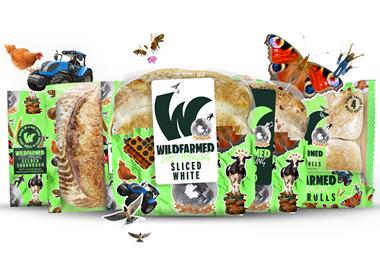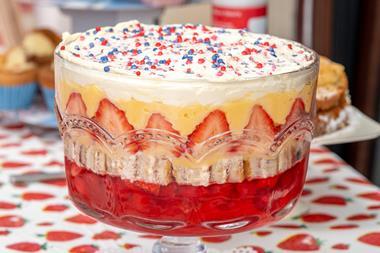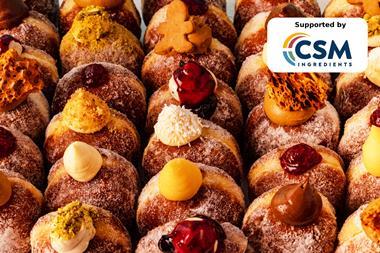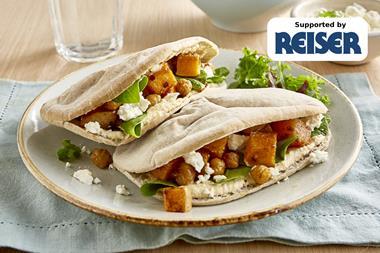Macarons are causing a stir on the UK wedding and afternoon tea scenes, but what colours, flavours and shapes are in vogue?
Classic, elegant, dainty – three words often used to describe macarons. But what about inventive? Instagram-worthy? A bold feminist statement?
As the colourful treats continue to capture the imagination of consumers, and cause a stir on the wedding and afternoon tea markets, there’s room for all types of macarons, from Ladurée’s classic French creations to London-based Ohlala’s Bloody Good tampons.
Admittedly the latter – which look like bloody tampons (see panel, p33) and are made in collaboration with a charity working to end period poverty – are more niche than others in the UK. But they do represent a significant move away from the norm.
So are these unique creations the future of macarons? What other flavours and designs will grab the nation’s attention in 2019 and beyond?
“Decoration trends will lead the way with macarons this year,” declares Jon Turonnet, foodservice sales manager at Brioche Pasquier, who notes the use of marbling to create a delicate finish.
“Shapes are becoming popular too, with a unicorn-shaped macaron being introduced to attract children and geometric shapes echoing a similar trend in cakes,” he adds.
Ohlala is ahead of the game with a number of shaped macarons in its portfolio, including unicorns, teddy bears, hearts, burgers and sandwiches. However, as CEO Meredith O’Shaughnessy confesses, shaped macarons take more work and impeccable piping control for an immaculate finish. “Darker colours are an up-and-coming trend and metallic is huge – I’m getting a lot of requests for gold leaf,” adds O’Shaughnessy.
But the colour depends on the occasion. “A box of beautiful pastel-coloured macarons is the wedding favour for modern brides,” says Jacqui Passmore, marketing manager at Dawn Foods.
One plus-side of macarons is that colour doesn’t denote flavour, allowing bakers to get creative and Bridezillas to get treats that match their colour theme exactly.
“We’re seeing growing interest in floral flavours such as geranium, violet, lavender and rose,” notes Turonnet. “The year could see floral and exotic flavours combining with successful marriages such as rose & lychee and violet & dark chocolate appearing.”
Brioche Pasquier has embraced fruit for its latest range of macarons, Notes Fruitées, featuring flavours such as pineapple, mandarin, green apple and blackcurrant.
“Traditional British recipes and flavours also work harmoniously with the form of a macaron,” explains Fabien Levet, commercial manager at Pidy UK. “For example, why not try to pick out the prominent flavours from everyone’s favourite chocolate bars and traditional treats, such as a Bounty or rocky road for a new contemporary take.”
The Real Macaron Company, based in Newbury, has been drawing inspiration from classic puds such as millionaire’s shortbread, coffee & walnut cake and combinations like peanut butter with chocolate, as well as last year’s royal wedding favourite elderflower and lemon.
“The other trend catching on is cocktail flavours,” says Gaye Perry, founder of The Real Macaron Company, pointing to piña colada and strawberry daquiri flavours among her portfolio. “Gin is also a thing and, as the flavours are so complex, there are lots of notes you can pull out to give taste to the macaron filling,” she adds.
Some even believe there’s an opportunity for savoury macarons. Pidy already offers an assortment in spicy and curry flavours while Ohlala’s past creations have included salmon & dill, goat’s cheese & sundried tomato, and bacon macarons. “Because it is just one bite you can get away with being really inventive,” believes O’Shaughnessy.
Despite all this innovation, it seems Brits can’t get enough of the classics. “As bespoke as macarons are, people come back to the same flavours. My most popular are salted caramel, raspberry, vanilla, lemon and pistachio,” says Perry.
This is echoed by other companies: Madagascan vanilla is Ohlala’s best-seller, while Edinburgh-based Mademoiselle Macaron’s is salted caramel.
Like Ohlala and The Real Macaron Company, Mademoiselle Macaron sells direct to consumers but chief mademoiselle Rachel Hanretty says there are pros and cons to this method. “Macarons can be so easily customised to individual requests. For example, you could have pink macaron shells with vanilla filling for your event and then pale pink shells filled with caramel for another event,” she says. “But it can be very difficult to manage these expectations and create bespoke orders that fit in with our standard production range.”
For small business owner Perry, the biggest challenge is the seasonality of demand. April to September is the busiest season due to the increase in weddings.
Those looking to go into mainstream retailers also face challenges. “Macarons can be frozen, meaning our wholesale customers can buy in bulk and use the stock as and when they need. However, this makes logistics and operations very difficult and expensive,” Hanretty adds, noting that she has yet to find a reasonably priced temperature-controlled shipping company.
But for wholesalers, retailers, bakers and caterers, there can be huge benefits from buying in macarons, including saving on labour costs, time and overheads.
“Macarons can be tricky for bakers or chefs to make from scratch unless they have specialist training. That’s when frozen, ready-made macarons can really make a difference in a bakery or kitchen,” says Charlotte Ganier, international development project manager at Tipiak.
“Serve them as part of a dessert menu, to decorate larger cakes or ice cream sundaes, in freak shakes, or as accompaniments to morning coffee.”
Whether classic or revolutionary, macarons can add French flair to any menu.
Mademoiselle Macaron, Edinburgh
Rachel Hanretty – aka Mademoiselle Macaron’s chief mademoiselle (right) – spent a year in Paris where she learned her craft.
In 2013, Mademoiselle Macaron was born and now produces between 6,000 and 10,000 macarons a week in a variety of flavours from best-selling salted caramel to rose or gin.
She attributes the rise in popularity of macarons to Pierre Hermé, who opened boutiques in Paris in 2001 as well as the international expansion of Ladurée, which now has six shops in London including sites
in Covent Garden, Westfield and in Harrods.
But for Hanretty, it was the way she saw the French treat macarons that drew her in.
“I remember seeing families hold their macarons as if they were precious jewels. They create little moments of luxury that transcend the effects of a humble cake on a plate,” she says. “I wanted to bring that magic and create a little bit of Paris for everyone.”
None of her menu items better reflect the fusion of Edinburgh and Paris than the Irn Bru macarons (right), or the Burns Night Box, which featured whisky and haggis-flavoured creations. She also draws inspiration from American classic desserts with pumpkin pie, s’mores and cookies & cream macarons featuring on her menu alongside floral flavours such as elderflower and lavender.
These undoubtedly caused a stir on social media – an important tool in Mademoiselle Macaron’s marketing arsenal.
“The colours and daintiness of macarons make it a perfect prop and feature for an Instagram or Facebook post. And thus PR and marketing was free because the product is so perfect – it all took care of itself,” she says.
Ohlala, London
CEO Meredith O’Shaughnessy (right) describes Ohlala as a “high-end bespoke, handmade business” that has become increasingly known for creating macarons with interesting shapes and embellishments.
Established in 2013, Ohlala made its name with martini and macaron workshops having “captured a moment in the luxury hen party market”. O’Shaughnessy hired a female
Le Cordon Bleu-trained pastry chef to take her business to the next level and has since gone on to work with luxury brands including Lulu Guinness and Manolo Blahnik.
One of Ohlala’s most notable collaborations was with charity Bloody Good Period to create tampon macarons. O’Shaughnessy says some people tried to warn her against making such a bold statement with macarons for fear it would ruin Ohlala. It didn’t.
“It’s something I’d like to do more of. It’s nice to know that baked goods can be used for good,” she adds, particularly as it reinforces Ohlala as a socially conscious company.
Selling to high-end clients requires the best of the best and Ohlala prides itself on its ingredients. “We only use organic eggs, source the best-quality almonds, we only use natural ingredients and don’t add any stabilisers,” she says.
With regards to marketing, O’Shaughnessy advises other macaron producers “appear where no one else is”, adding that LinkedIn has worked well for Ohlala, although 80% of its business is from recommendations. Having looked into selling via retailers, the right fit for Ohlala was direct to consumer.
“With direct to consumer we can respond really quickly to market demand and trends. We can hear what the customers want and create it. That’s really fulfilling,” she explains.


























No comments yet